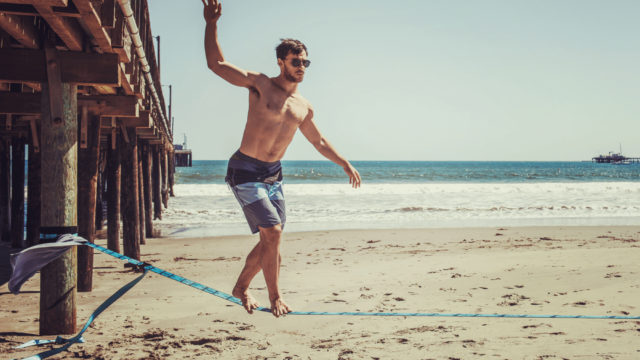
Stay Fit While Traveling and Working Online

After 3 years on the road my well-being was suffering. That is until I discovered these health hacks…
By Lucia Wang
Back in 2016 I was living in Bali after having quit my ad agency job in Singapore. The initial reason I moved to a tropical island was to lower my cost of living while working on my own business. After spending some time living in Bali, I was immediately drawn into a community of digital natives who travel with their laptops. They refer to themselves as “digital nomads”.
Ever since I got to know this new lifestyle, I did my fair share of globetrotting with my laptop. I spent my weekends catching airplanes and chasing WiFi. My U.S.-based remote job had flexible hours, so I spent all my free time exploring new, exotic destinations from Bangkok to Barcelona.
While 3 years on the road broadened my mind, it did lead to health sacrifices. Back when I lived in Singapore, I hit the gym at least 3 times a week. But on the road the lack of routine and constant change in time zones made it very hard to stick to a healthy lifestyle.
It takes tremendous commitment to stay fit while travelling and working, but it is possible. Here’s how I figured out a way to stay healthy and active while travelling so you can enjoy your worldly pursuits and stay active, too!
Tip #1: Sleep well (when you aren’t jetlagged)
When you travel between time zones, a good nights sleep becomes a luxury and long-haul flights are full of interruptions. You have to wake up for meals, flight announcements and other passenger requests. Not to mention horrible airplane seats, stiff pillows and limited legroom, none of which aide sleep.
But once you’re off the flight the torture has only just begun. You’ll be suffering from lack of sleep from jet lag for days to come. As stated in this research article, jet lag is caused by a change in light exposure, time and melatonin levels when you travel between time zones.
I try to split up long-haul flights into shorter journeys, so my body can adjust to a new time zone with a few stopovers. I also avoid drinking coffee or alcohol on the day of the flight, as well as limit my exposure to blue lights. I use an app called Timeshift to prevent jet lag. You’ll find a long list of tips here to get better sleep after a long flight.
Tip #2: Create a healthy recipe bank (and cook as much as you can)
I hear you: why on earth would one resist eating out when a big bonus of travel is to discover local flavors? While I do eat out regularly when travelling, I like to keep a familiar food list that I can prepare myself. Because I travel slowly I often stay in local apartments with a kitchen. I try to cook as much as possible following a recipe bank that I developed over time.
There are three main benefits for a recipe bank. First off, it makes cooking a lot easier with minimal planning. When you build your recipe bank around a few staple foods, you can save a lot of money and time with more efficient food shopping. Also with personalized recipes, you avoid excessive calorie intake and nutrition deficiency.
For example, I know that I need vitamin B1 rich foods, so I developed a recipe list featuring ingredients like sunflower seeds and brown rice. I followed this comprehensive guide on creating a recipe bank using a bullet journal. Here’s a free healthy recipe bank that you can use to build your own list. You can also find plenty of budget recipe boards on Pinterest such as this one.
Tip #3: Follow simple ’anywhere you are’ workout routines
One of the biggest challenges to staying fit is finding time to hit the gym. In between a full time job and hectic travel planning, there isn’t much time and energy left for exercises and due to the constant change of location, it’s difficult to follow through with local training programs.
This set of constraints gives birth to creative solutions. For me, it’s finding easy-to-follow home workouts that I can perform in tiny spaces. With a foldable yoga mat (travel size), and a bedroom big enough, you can get moving in your pyjamas.
I like to do quick vinyasa flow or pilates exercises in the morning to get my blood flowing. I’m also a big fan of bodyweight workouts, most of which are very apartment-friendly. This article has a long list of bodyweight exercises that are easy to follow at home.
Tip #4: Get creative and find space to exercise
A lot of “digital nomads” are chasing the sun all year round. That means travelling to tropical places when winter hits. So when it’s sunny why not exercise outdoors? That way you can really take advantage of the abundant natural vitamin D!
Lots of tropical places I’ve travelled to are great for outdoor workouts and sometimes I find the best locations aren’t typical “workout” spots. For example, getting up early for a beach bootcamp at sunrise is both energizing and inspirational. I’ve also hiked up the Campuhan ridge walk in Bali, which is a scenic running trail through rice fields.
Another benefit of exercising outdoors is you can join in with others which keeps you motivated. In Lisbon, lots of surf enthusiasts hit up the waves on the beach of Costa da Caparica and find other surfers along the way.
Tip #5: Use Fitness Wearables to Track Your Health
For the longest time, I was exercising with no idea whether my health was improving as a result. For example, how many calories did I burn from a 30 minute HIIT workout? And how was my heart performing during the exercises? These were not questions I thought of as relevant.
It all changed when I realized that weight loss is simple maths – how many calories do you take in versus how many you burn. If you need to burn 500 calories a day from exercise, and that long walk in the park burns 200 calories, you might want to kick it up a notch by doing some strength and cardio to balance it out.
That’s when I turned to wearables, for their unobtrusive way of tracking health. Most wearables collect and analyze personal data for you so it’s much easier to plan and regulate your health routines. The movement reminder is especially useful: when I’ve been in the same sedentary position for longer than an hour, it reminds me to take a few steps.
Smartwatches are also powerful wearables that go beyond fitness tracking. Here is a list of benefits for using smartwatches. I’m especially excited by their ability to automatically change time zone and display secondary time zones when travelling.
Tip #6: Take Advantage of Cross-Border Gym Passes
Throughout my travels I’ve always wished for a way to hit local gyms without having to sign up for a fixed-term contract. Most gyms require a few months commitment at least. And when you’re only in town for a short while, the contract penalty and hefty registration fee makes no sense.
I searched long and hard for a membership that would allow multi-city or even multi-country flexibility with just one membership.
In Europe the best one is Urban Sports Club, which allows you to use one membership to access a broad variety of sports venues across Europe. It covers all the major cities in Germany, Spain, France, Portugal and Italy. Now that I’m based in Lisbon, I really enjoy using it to discover boutique gyms. With every tariff, I can also travel to other parts of Europe and continue to stay fit.
Conclusion
With a few helpful tips, health challenges while traveling the world are easy to overcome – even if you are short on time. What matters most is that we enjoy the moment, make the most of our time and constantly improve – because travel is an investment in ourselves.
How do you stay active while travelling? Can you put my tips into practice? I’d like to hear what others have to say about their fitness challenges and how they overcome them.



Comments